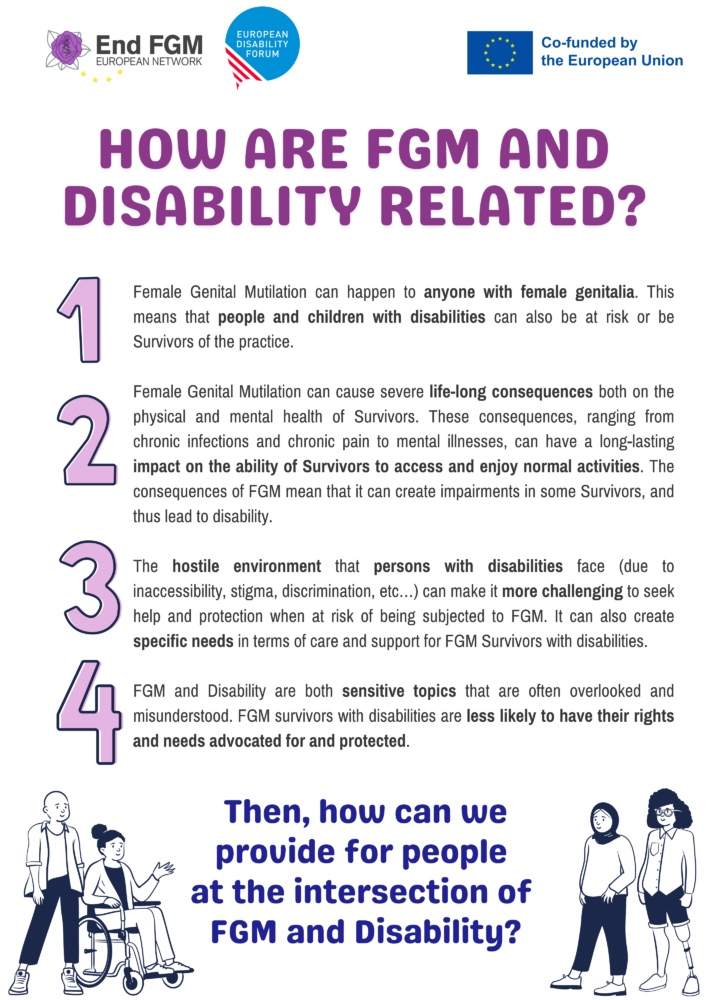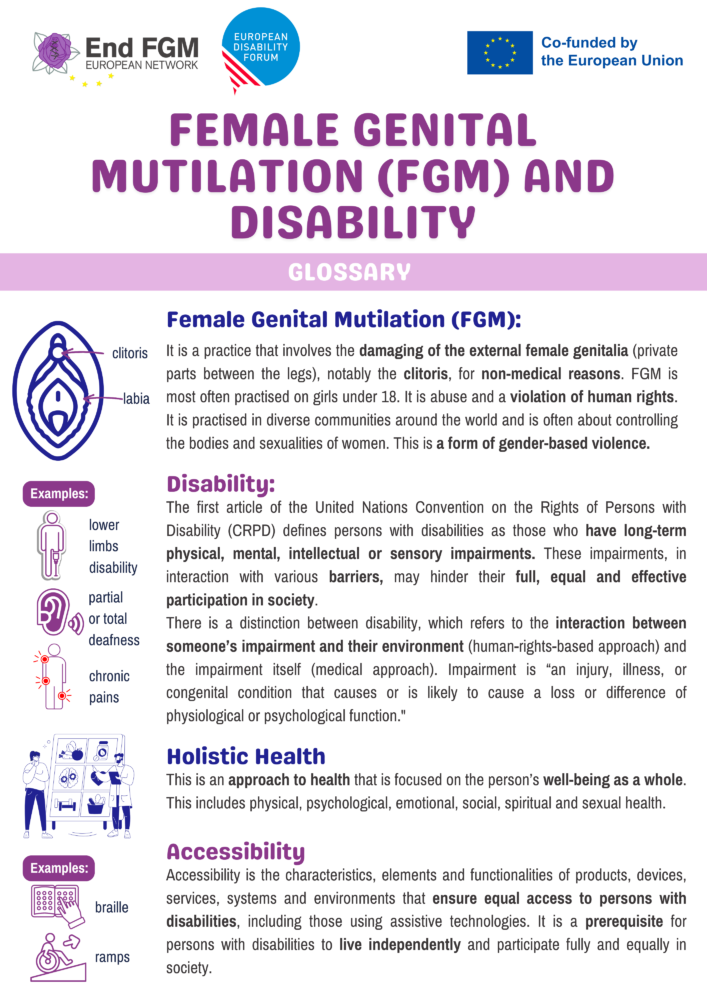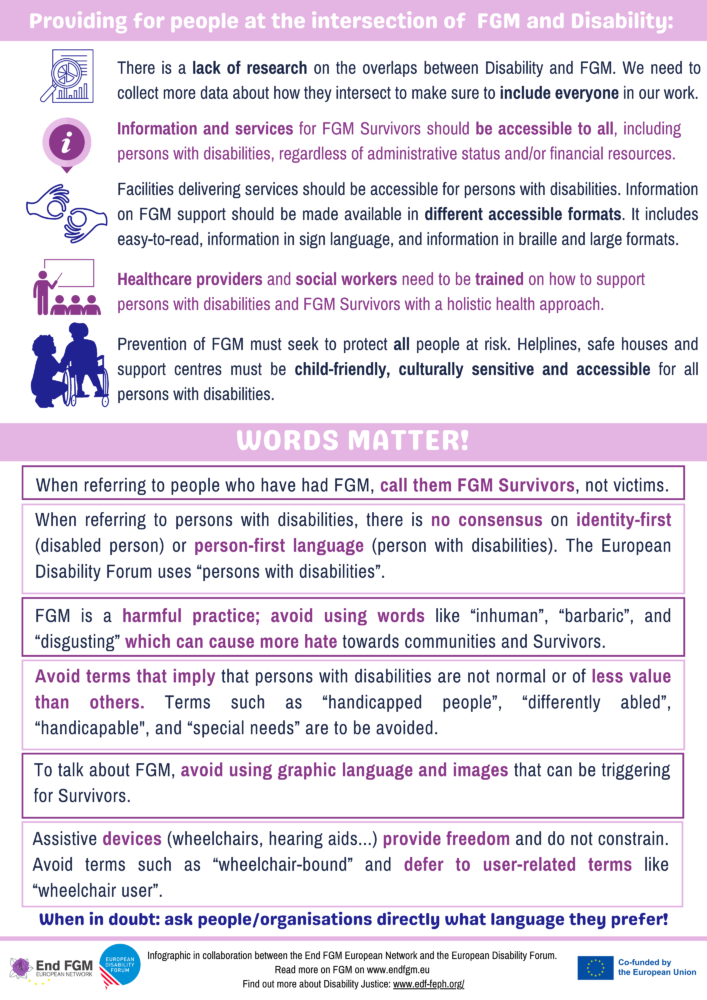Female Genital Mutilation Survivors with disabilities are less likely to have their rights upheld and less likely to have support.
To support our members’ knowledge of the issue, we collaborated with the End FGM European Network to prepare an infographic on Female Genital Mutilation and Disability.
Download the infographic below
- You can download the infographic (PDF – 600 kb)
- You can access a text-version of the infographic (Word)
See the infographic below
Page 1 – text version
The infographic starts with a glossary.
The first definition is Female Genital Mutilation (FGM): It is a practice that involves the damaging of the external female genitalia (private parts between the legs), notably the clitoris, for non-medical reasons. FGM is labia most often practised on girls under 18. It is abuse and a violation of human rights. It is practised in diverse communities around the world and is often about controlling the bodies and sexualities of women. This is a form of gender-based violence. On the left of the text, you can find an anatomically correct illustration of the female genitalia, showing a label for a blue circle on the top half called the clitoris. An almost circular structure in the middle is called the labia.
The second definition is Disability: The first article of the United Nations Convention on the Rights of Persons with Disability (CRPD) defines persons with disabilities as those who have long-term limbs physical, mental, intellectual or sensory impairments. These impairments, in disability interaction with various barriers, may hinder their full, equal and effective participation in society. There is a distinction between disability, which refers to the interaction between someone’s impairment and their environment (human-rights-based approach) and the impairment itself (medical approach). Impairment is “an injury, illness, or pains congenital condition that causes or is likely to cause a loss or difference of physiological or psychological function.”
Next to the second definition, there is an illustration with some examples: on the top the outline of a person in purple with a prosthetic device on his left leg. Next to it, text says “lower limbs disability”; in the middle, an ear with sound waves leaving. Next to it, text says partial or total deafness. At the bottom, a person with red dots in several parts illustrates pain. Next to it text says chronic pains.
The third definition is Holistic Health: This is an approach to health that is focused on the person’s well-being as a whole. This includes physical, psychological, emotional, social, spiritual and sexual health. On the left, there is an illustration of two people looking at a screen bigger than them. On the screen are several representations of health, such as healthy food, supplements, and a heart.
The fourth definition is accessibility: Accessibility is the characteristics, elements and functionalities of products, devices, services, systems and environments that ensure equal access to persons with disabilities, including those using assistive technologies. It is a prerequisite for persons with disabilities to live independently and participate fully and equally in society. On the left of the definition, two illustrations of examples: a book in braille and a person in a wheelchair going up a ramp.
Page 2 – text version
The second page has the title: “How are FGM and Disability related?”
An oversized number 1 in purple starts the first point: Female Genital Mutilation can happen to anyone with female genitalia. This means that people and children with disabilities can also be at risk or be survivors of the practice.
An oversized number 2 in purple precedes the second reason: Female Genital Mutilation can cause severe life-long consequences both on the physical and mental health of Survivors. These consequences, ranging from chronic infections and chronic pain to mental illnesses, can have a long-lasting impact on the ability of Survivors to access and enjoy normal activities. The consequences of FGM mean that it can create impairments in some Survivors and thus lead to disability.
An oversized number 3 in purple introduces the third point: the hostile environment that persons with disabilities face (due to inaccessibility, stigma, discrimination, etc.) can make it more challenging to seek help and protection when at risk of being subjected to FGM. It can also create specific needs in terms of care and support for FGM Survivors with disabilities.
A large number 4 in purple introduces the last point: FGM and Disability are both sensitive topics that are often overlooked and misunderstood. FGM survivors with disabilities are less likely to have their rights and needs advocated for and protected.
The page closes with the question: “Then, how can we provide for people at the intersection of FGM and Disability?” in big blue letters. The sentence is surrounded by illustrations of people: on the left, a woman in a wheelchair next to a person. On the right, a woman wearing a headscarf next to a woman with a prosthetic leg.
The third page starts with the section “Providing for people at the intersection of FGM and Disability”. It is divided in 5 paragraphs, each starting with an illustration.
An illustration of a magnifier looking at a page with graphs opens the first point: there is a lack of research on the overlaps between Disability and FGM. We need to collect more data about how they intersect to make sure to include everyone in our work.
The second point (in purple) includes a sign showing an info point and the text: information and services for FGM Survivors should be accessible to all, including persons with disabilities, regardless of administrative status and/or financial resources.
The third point shows two hands making a sign and says: facilities delivering services should be accessible for persons with disabilities. Information on FGM support should be made available in different accessible formats. It includes easy-to-read, information in sign language, and information in braille and large formats.
The outline of a person showing sometthing on a chalkboard precedes the point that healthcare providers and social workers need to be trained on how to support persons with disabilities and FGM Survivors with a holistic health approach.
Finally, an illustration in blue of person kneeling next to someone in a wheelchair illustrates “Prevention of FGM must seek to protect all people at risk. Helplines, safe houses and support centres must be child-friendly, culturally sensitive and accessible for all persons with disabilities.”
The second part of the third page starts with the title: “Words matter”. A list of advice includes:
- When referring to people who have had FGM, call them FGM Survivors, not victims.
- Avoid terms that imply that persons with disabilities are not normal or of less value than others. Terms such as “handicapped people”, “differently abled”, “handicapable”, and “special needs” are to be avoided.
- When referring to persons with disabilities, there is no consensus on identity-first (disabled person) or person-first language (person with disabilities). The European Disability Forum uses “persons with disabilities”.
- FGM is a harmful practice; avoid using words like “inhuman”, “barbaric”, and “disgusting” which can cause more hate towards communities and Survivors.
- To talk about FGM, avoid using graphic language and images that can be triggering for Survivors.
- Assistive devices (wheelchairs, hearing aids…) provide freedom and do not constrain. Avoid terms such as “wheelchair-bound” and defer to user-related terms like “wheelchair user”.
The infographic end with the sentence “When in doubt: ask people/organisations directly what language they prefer!”
Footnotes on the last page:
- Infographic in collaboration between the End FGM European Network and the European Disability Forum.
- Read more on FGM on endfgm.eu
- Find out more about Disability Justice: edf-feph.org/

